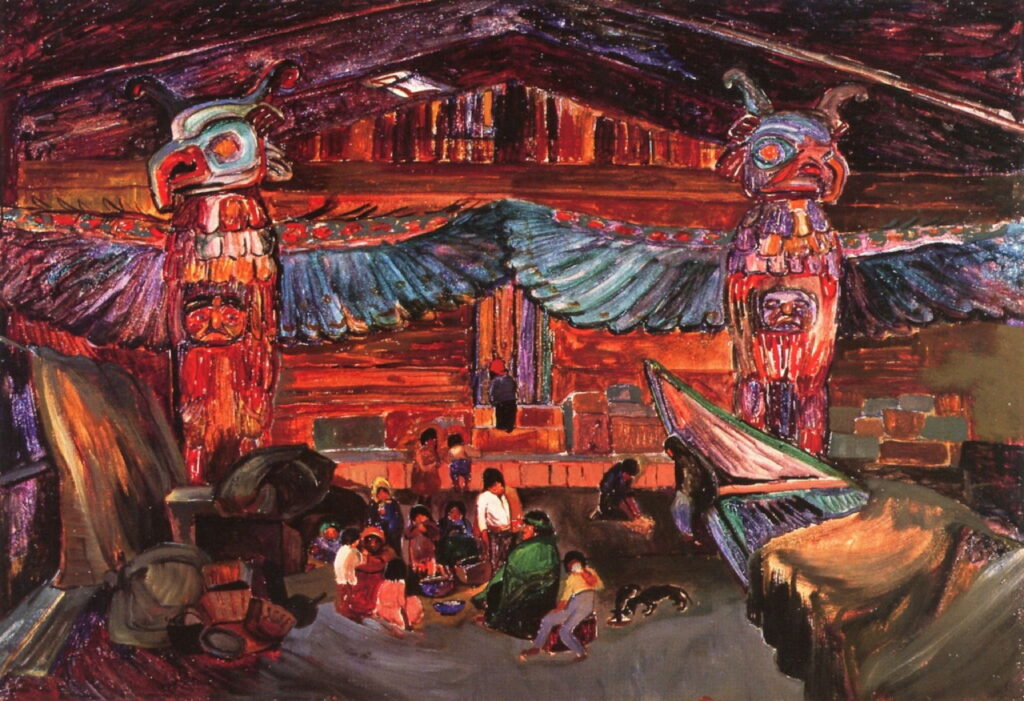Emily Carr’s paintings: Haida 1912-1913

In 1912, when Emily Carr returned to Vancouver from Paris, she established herself there as a Fauvist when exhibiting her work from France in her studio. Equipped with what she had learned over the last 22 years in California, Canada, and Europe, she then set out on her project to document the peoples of the First Nations of the north-west coast.
In the summer of 1912, she travelled north to Haida Gwaii (formerly Queen Charlotte Islands), the Upper Skeena River, and Moresby Island. She there documented the totems and buildings of the Haida, Gitxsan, and Tsimshian peoples. Following that, she returned to Vancouver to teach and work, then returned north when she could afford to.
Emily Carr (1871–1945), Cumshewa (1912), watercolour with graphite and gouache on hardboard, 55.8 x 75.4 cm, Private collection. The Athenaeum.
Cumshewa (1912) is a watercolour showing totems and part of the Haida settlement of Cumshewa, in the Haida Gwaii archipelago off the coast of British Columbia. It had been a centre of the maritime fur trade until the early nineteenth century, and was named in commemoration of an important Haida chief during that period of trade. Carr remarked on its incessantly damp climate.
Emily Carr (1871–1945), Potlatch Figure (Mimquimlees) (1912), oil on canvas, 46 x 60.3 cm, National Gallery of Canada / Musée des beaux-arts du Canada, Ottawa, ON. The Athenaeum.
Potlatch Figure (Mimquimlees) (1912) shows a figure who had been involved in gift-giving practices that had been banned by the Canadian government, until they were eventually decriminalised after the Second World War.
Potlatches were held as rites of passage, on the occasion of births, deaths, weddings, etc., and typically more often during winter. A feast was hosted by the rich, and attended by their kin group. This was accompanied by the exchange of gifts, in the distribution and sometimes destruction of property that was an important part of the dynamic, and the features that concerned government.
Emily Carr (1871–1945), Skedans Poles, Queen Charlotte Islands (1912), watercolour on paper, 55.9 x 76.5 cm, Royal BC Museum, Victoria, BC. The Athenaeum.
Skedans Poles, Queen Charlotte Islands (1912) is a watercolour showing a remarkable array of totems at this Haida village in Haida Gwaii. It’s now part of the Gwaii Haanas National Park Reserve and Haida Heritage Site, and a National Historic Site of Canada in its own right.
Emily Carr (1871–1945), Skidegate (1912), oil on board, 65.4 x 32.5 cm, Vancouver Art Gallery, Vancouver, BC. The Athenaeum.
Skidegate (1912) shows a single totem in another Haida community in Haida Gwaii.
Emily Carr (1871–1945), Tanoo (1912), watercolour, 74.5 x 52.2 cm, McMichael Canadian Art Collection, Kleinburg, ON. The Athenaeum.
Tanoo (1912) is a watercolour of two totems at another Haida site in the Haida Gwaii archipelago, near Cumshewa.
Emily Carr (1871–1945), Tsatsisnukomi, B.C. (1912), watercolour and graphite on paper, 55.2 x 75.6 cm, Vancouver Art Gallery, Vancouver, BC. The Athenaeum.
Carr’s watercolour of Tsatsisnukomi, B.C. (1912) was probably painted on the British Columbia mainland near Johnstone Strait, to the north of Vancouver Island, in which case it shows totems of the Tlowitsis Nation of the Kwakwaka’wakw peoples.
Emily Carr (1871–1945), First Nations War Canoes in Alert Bay, 1912 (1912), further details not known. Wikimedia Commons.
First Nations War Canoes in Alert Bay, 1912 (1912) shows three large canoes in this Kwakwaka’wakw village on Cormorant Island, which is just off the north coast of Vancouver Island. Unusually for Carr’s paintings, it includes a small group of figures talking together under the prominent tree behind the canoes. As far as I can tell, this is a finished oil version derived from a watercolour painting that is considerably less Fauvist.
Emily Carr (1871–1945), Yan, Q.C.I. (1912), oil on canvas, 99.5 x 153 cm, Art Gallery of Hamilton, Hamilton, ON. The Athenaeum.
Yan, Q.C.I. (1912) must be one of Carr’s finest paintings of this campaign in the north of British Columbia. It shows an arc composed of numerous totems in this bay in Haida Gwaii, during the summer when the flowers are in full bloom. The colours are vibrant but not garish or dazzling, and her brushwork develops a rich range of textures.
Emily Carr (1871–1945), Indian House Interior with Totems (1913), oil on canvas, 89.5 x 130.5 cm, Vancouver Art Gallery, Vancouver, BC. The Athenaeum.
Indian House Interior with Totems (1913) is another superb painting, showing the interior of a large house with its brightly painted totems, complete with a kin group, pets, and possessions.
Emily Carr (1871–1945), Vancouver Street (1912-13), oil on card, 18.4 x 22.9 cm, Private collection. The Athenaeum.
She also painted some views of the south, including this strongly Fauvist Vancouver Street (1912-13), a marked contrast from her more rigorously documentary depictions of totems and villages in the north.
In 1913, Carr organised an exhibition of two hundred of her paintings from her travels to the north, the largest solo exhibition mounted by an artist in Vancouver at that time. Reaction to her paintings and a lecture she gave on them was mixed: when she offered her paintings to the new provincial museum, they were refused, and the minister of education failed to offer any support.
Carr decided to return to Victoria, where some of her sisters still lived. For the next thirteen years, she concentrated her attention on running a boarding house on Simcoe Street, and seldom painted.
References
Wikipedia.
Lisa Baldissera (2015) Emily Carr, Life & Work, Art Canada Institute. ISBN 978 1 4871 0044 5. Available in PDF from Art Canada Institute.
Thom, Ian M (2013) Emily Carr Collected, Douglas & McIntyre. ISBN 978 1 77100 080 2.

